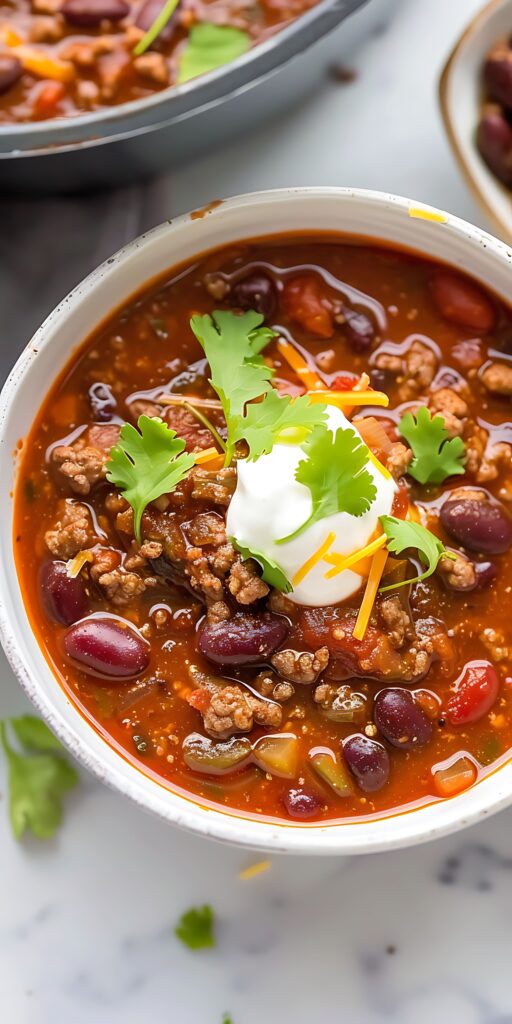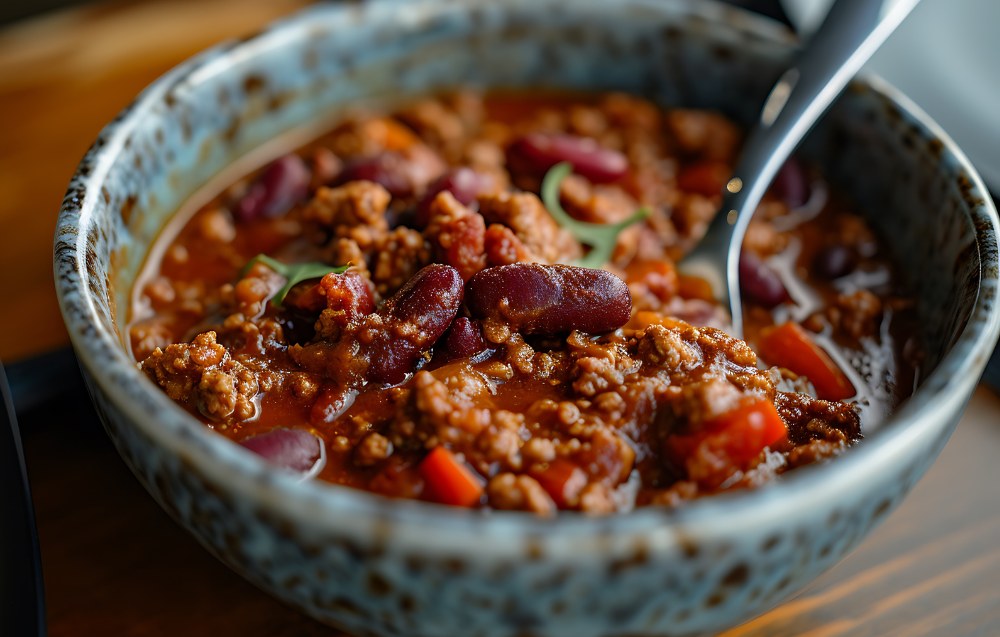There’s something magical about a steaming bowl of good chili. It’s hearty, comforting, and packed with flavors that dance on your taste buds. But what’s the secret to making a chili that stands out? Is it the spices, the cooking method, or something else entirely? Well, my friend, you’re about to find out. Whether you’re a chili novice or a seasoned pro, this guide will take you on a flavorful journey to mastering the art of chili-making. So, grab your apron, and let’s dive in!
Table of Contents
Introduction: Why Chili is a Beloved Dish
Chili is more than just a dish—it’s a cultural icon. From backyard cookouts to chilly winter nights, chili has a way of bringing people together. It’s versatile, customizable, and downright delicious. But here’s the thing: not all chilis are created equal. Some are too watery, others too bland, and some are just…meh. So, what separates a good chili from a great one? The answer lies in the details—the ingredients, the techniques, and the little secrets that elevate it from ordinary to extraordinary.
“Chili is not just a meal; it’s an experience. It’s the warmth of a shared bowl, the laughter around the table, and the memories that linger long after the last bite.” – Unknown
The History of Chili: From Humble Beginnings to Global Fame
Before we get into the nitty-gritty of making good chili, let’s take a quick trip down memory lane. Chili’s origins are as rich and varied as its flavors. While its exact birthplace is debated, many believe it traces back to the American Southwest or Northern Mexico. Early versions were simple—dried beef, fat, and chili peppers pounded together and dried into bricks. These “chili bricks” were portable and could be rehydrated with water, making them a staple for cowboys and travelers.
Over time, chili evolved. Tomatoes, beans, and spices were added, and regional variations emerged. Today, chili is a global phenomenon, with countless recipes and styles. But no matter how it’s made, one thing remains constant: chili is a dish that brings people together.
What Makes a Great Chili? The Key Elements
So, what’s the secret to good chili? It’s not just one thing—it’s a combination of factors. Let’s break it down.
The Foundation: Choosing the Right Ingredients
Great chili starts with great ingredients. It’s like building a house—you need a solid foundation. Here’s what you need to know:
Meat Matters: Selecting the Best Protein for Your Chili
The protein you choose can make or break your good chili. Ground beef is a classic choice, but don’t be afraid to mix it up. Chuck roast, ground turkey, or even bison can add unique flavors and textures. The key is to use high-quality meat with a good fat-to-lean ratio. Fat equals flavor, after all. If you’re feeling adventurous, try a Brisket Chili Recipe—it’s a game-changer for meat lovers.
Beans or No Beans? The good Chili Debate
Ah, the age-old question: to bean or not to bean? Purists argue that good chili doesn’t include beans, while others swear by them. Personally, I think it’s a matter of preference. Kidney beans, black beans, or pinto beans can add heartiness and texture. If you’re team no-bean, that’s cool too. Just make sure your chili has enough substance to stand on its own. Speaking of hearty dishes, have you ever tried The Main Ingredients In Salisbury Steak? It’s another comfort food classic that’s all about rich, savory flavors.
The Role of Tomatoes: Fresh vs. Canned
Tomatoes are the backbone of most good chili recipes. They add acidity, sweetness, and depth. But should you use fresh or canned? While fresh tomatoes are great, canned tomatoes are often more consistent and convenient. Plus, they’re picked at peak ripeness, so they pack a flavor punch. Just make sure to choose high-quality canned tomatoes without added preservatives. If you’re a fan of tangy flavors, you might also love adding Banana Pepper to your good chili for a little extra zing.
Spices and Seasonings: The Heart of Flavor
Spices are where the magic happens. good chili powder, cumin, paprika, and garlic are the usual suspects, but don’t stop there. Experiment with smoked paprika, coriander, or even a pinch of cinnamon. The key is to layer your spices—add some at the beginning for depth and some at the end for brightness. If you’re looking for inspiration, check out this Salisbury Steak Recipe—it’s packed with spices that create a symphony of flavors.
The Cooking Process: Techniques for good Chili
Now that we’ve covered the ingredients, let’s talk technique. How you cook your good chili is just as important as what you put in it.
Searing vs. Browning: Which is Better for Meat?
When it comes to cooking your meat, searing is the way to go. Searing creates a caramelized crust that locks in flavor. Browning, on the other hand, can dry out the meat. So, heat your pan until it’s smoking hot, add your meat in small batches, and let it sear without stirring. Trust me, your taste buds will thank you. This technique also works wonders in dishes like Easy Steak Pasta, where searing the steak adds a rich, savory depth.
Slow Cooking vs. Instant Pot: Finding the Right Method
Slow cooking is the traditional method for making good chili. It allows the flavors to meld together and the meat to become tender. But if you’re short on time, an Instant Pot can work wonders. It’s faster but still delivers rich, deep flavors. The choice is yours—just make sure to give your good chili enough time to develop its flavors.
Layering Flavors: When to Add Ingredients
Timing is everything when it comes to adding ingredients. Start with your aromatics (onions, garlic, and peppers) to build a flavor base. Then add your spices and meat. Finally, add your liquids and beans (if using). This layering technique ensures that every bite is packed with flavor.

Common Problems When Making Good Chili (and How to Fix Them)
Even the best chefs run into problems when making good chili. But don’t worry—I’ve got you covered. Here are some common issues and how to fix them.
Problem 1: Chili is Too Spicy
We’ve all been there—your good chili is so spicy it feels like your mouth is on fire. But don’t panic! There are ways to tone down the heat.
Solution: Balancing Heat with Sweetness and Acidity
Adding a touch of sweetness can help counteract the spiciness. Try stirring in a bit of honey, maple syrup, or even a splash of orange juice. Acidic ingredients like lime juice or vinegar can also help balance the heat. And if all else fails, serve your chili with a dollop of sour cream or a sprinkle of cheese to cool things down.
Problem 2: Chili is Too Watery
Nothing’s worse than a watery chili. It’s like soup pretending to be chili. But don’t worry—there’s an easy fix.
Solution: Thickening Your Chili Like a Pro
There are several ways to thicken your good chili. You can simmer it uncovered to reduce the liquid, or add a slurry of cornstarch and water. Another trick is to mash some of the beans and stir them back into the pot. This adds thickness without altering the flavor.
Problem 3: Chili Lacks Depth of Flavor
If your chili tastes flat, it’s probably missing depth. But don’t worry—there are ways to amp up the flavor.
Solution: Umami Boosters and Secret Ingredients
Umami is the secret to rich, savory flavors. Add ingredients like soy sauce, Worcestershire sauce, or even a splash of fish sauce. A square of dark chocolate or a spoonful of cocoa powder can also add depth and complexity. And don’t forget to season with salt—it’s the ultimate flavor enhancer.
Problem 4: Chili is Too Bland
Bland chili is a crime against taste buds. But fear not—there’s a way to rescue it.
Solution: Amplifying Flavor with Spices and Herbs
If your chili is bland, it’s probably under-seasoned. Don’t be shy with your spices—add more chili powder, cumin, or paprika. Fresh herbs like cilantro or parsley can also brighten up the flavor. And don’t forget to taste as you go. Adjust the seasoning until it’s just right.
The Secret Ingredients for Award-Winning Good Chili
Now that we’ve covered the basics, let’s talk about the secret ingredients that can take your chili from good to award-winning. These are the little extras that add depth, complexity, and a touch of magic to your dish.
Chocolate and Coffee: Unexpected Flavor Enhancers
Yes, you read that right—chocolate and coffee. These might sound like dessert ingredients, but they’re secret weapons in savory dishes like chili. A small square of dark chocolate or a teaspoon of cocoa powder adds richness and depth, while a splash of brewed coffee enhances the smoky, earthy flavors. It’s like adding a hidden layer of flavor that keeps people coming back for more.
Broth: Liquid Gold for Your Good Chili
The liquid you use in your chili can make a huge difference. While water works in a pinch, broth can elevate your good chili to new heights. Broth, whether it’s beef, chicken, or vegetable, adds a savory depth that water just can’t match. For more tips on using broth in cooking, check out this guide on how to make homemade broth from Serious Eats.
Acidic Ingredients: Brightening Your Good Chili
Acidic ingredients like lime juice, vinegar, or even a splash of tomato paste can brighten up your chili and balance the richness. They add a tangy kick that cuts through the heaviness and makes the flavors pop. Think of it as the squeeze of lemon that brings a dish to life.
Vegetarian and Vegan Chili: Tips for Meat-Free Perfection
Chili isn’t just for meat lovers. Vegetarian and vegan chili can be just as hearty and flavorful, if not more so. Here’s how to make a meat-free chili that even carnivores will love.
Best Meat Substitutes for Good Chili
If you’re skipping the meat, you’ll need a good substitute to add texture and heartiness. Lentils, mushrooms, and textured vegetable protein (TVP) are all great options. Lentils cook down to a meaty texture, while mushrooms add an umami-rich flavor. TVP, on the other hand, mimics the texture of ground meat almost perfectly. For more ideas on plant-based protein, check out this article on the best meat substitutes from Healthline.
Maximizing Flavor Without Meat
Without meat, you’ll need to rely on other ingredients to build flavor. Roasted vegetables, smoked paprika, and umami-rich ingredients like soy sauce or miso paste can add depth and complexity. Don’t forget to load up on spices—they’re the key to a flavorful vegetarian chili.
Serving and Pairing: How to Elevate Your Good Chili Experience
Good Chili is a versatile dish that can be served in countless ways. Whether you’re hosting a party or enjoying a cozy night in, here’s how to make your chili experience unforgettable.
Toppings Galore: The Ultimate Good Chili Garnishes
Toppings are where you can get creative. Shredded cheese, sour cream, avocado, green onions, and fresh cilantro are all classic choices. But why stop there? Try crushed tortilla chips, pickled jalapeños, or even a drizzle of hot sauce for an extra kick. For more topping inspiration, check out this list of creative chili toppings from Food Network.
Side Dishes That Complement Chili Perfectly
Good Chili is a meal on its own, but the right side dish can take it to the next level. Cornbread, garlic bread, or a simple green salad are all great options. If you’re feeling adventurous, try serving your chili over baked potatoes or rice for a hearty twist.
Regional Chili Variations: Exploring Different Styles
Good Chili is a dish that’s as diverse as the people who make it. Across the globe, different regions have put their own spin on this classic comfort food. Whether you’re a fan of Texas-style chili or prefer something a little more unconventional, there’s a chili variation out there for everyone. Let’s take a culinary tour of some of the most popular regional chili styles.
Texas Chili: No Beans, Just Meat
When it comes to chili, Texans don’t mess around. Traditional Texas chili, also known as “chili con carne,” is all about the meat. Beans? Forget about it. This style focuses on slow-cooked chunks of beef, usually chuck roast or brisket, simmered in a rich, spicy sauce made from chili peppers, garlic, and cumin. The result is a thick, hearty chili that’s packed with flavor. If you’re a purist, this is the chili for you.
Cincinnati Chili: A Unique Twist with Spaghetti
Cincinnati chili is a whole different beast. This regional favorite is served over spaghetti and topped with a mountain of shredded cheese, onions, and kidney beans. The chili itself is thinner and sweeter than traditional versions, often flavored with cinnamon, cloves, and even a touch of cocoa powder. It’s a quirky, delicious take on chili that’s worth trying at least once.
White Chicken Chili: A Lighter Alternative
If you’re looking for something a little lighter, white chicken chili is the way to go. Made with tender chicken, white beans, and a creamy broth, this chili is flavored with green chilies, cumin, and cilantro. It’s a refreshing change from the usual beef-based chili and perfect for those who prefer milder flavors. Plus, it’s a great way to use up leftover rotisserie chicken.
Storing and Reheating Chili: Tips for Maximum Freshness
Let’s be real—chili often tastes even better the next day. The flavors have more time to meld together, creating a dish that’s richer and more complex. But to enjoy those leftovers, you need to know how to store and reheat your chili properly. Here’s how to keep your chili fresh and delicious.
How to Store Chili for Later Use
Storing chili is pretty straightforward, but there are a few tips to keep in mind. First, let your chili cool completely before transferring it to an airtight container. This prevents condensation, which can make your chili watery. If you’re planning to eat it within a few days, the fridge is your best bet. For longer storage, freeze your chili in portion-sized containers. It’ll keep for up to three months in the freezer.
Reheating Chili Without Losing Flavor
Reheating chili is easy, but there’s a right way to do it. If you’re reheating on the stovetop, add a splash of broth or water to keep it from drying out. Stir frequently to ensure even heating. In the microwave, cover your chili with a damp paper towel to lock in moisture and prevent splatters. And if you’re reheating frozen chili, let it thaw in the fridge overnight for the best results.
Frequently Asked Questions About Making Chili
Even after all these tips, you might still have a few questions about making chili. Don’t worry—I’ve got you covered. Here are some of the most common questions and their answers.
How Long Should Chili Simmer for the Best Flavor?
The longer you simmer your chili, the better it’ll taste. A good rule of thumb is to let it simmer for at least an hour, but two to three hours is even better. This gives the flavors time to develop and the meat time to become tender. If you’re using a slow cooker, you can let it cook on low for six to eight hours.
Can You Freeze Chili? Tips for Freezing and Thawing
Absolutely! Chili freezes beautifully. Just make sure to cool it completely before transferring it to freezer-safe containers. Leave a little room at the top, as the chili will expand as it freezes. When you’re ready to eat, thaw it in the fridge overnight and reheat it on the stovetop or in the microwave.
What’s the Best Way to Reheat Chili?
The best way to reheat chili depends on how much time you have. On the stovetop, heat it over medium-low heat, stirring occasionally, until it’s warmed through. In the microwave, use a microwave-safe dish and cover it with a damp paper towel to prevent splatters. Either way, add a splash of broth or water to keep it from drying out.
Conclusion: Mastering the Art of Chili
Chili is more than just a dish—it’s a labor of love. It’s about experimenting with flavors, tweaking recipes, and finding what works best for you. Whether you’re a fan of traditional Texas chili, adventurous enough to try Cincinnati-style, or looking for a lighter option like white chicken chili, there’s no wrong way to make it. The secret to good chili isn’t just in the ingredients or the techniques—it’s in the joy of creating something delicious to share with others.
Final Tips for Perfecting Your Chili Recipe
- Taste as you go: Don’t be afraid to adjust the seasoning as you cook.
- Experiment: Try new ingredients and techniques to keep things interesting.
- Have fun: Cooking should be enjoyable, so don’t stress too much about getting it “perfect.”
Why Chili is More Than Just a Dish—It’s a Tradition
At its core, chili is about connection. It’s the dish you make for family gatherings, potlucks, and game day parties. It’s the meal that brings people together, warms you up on a cold day, and leaves you feeling satisfied. So, the next time you make a pot of chili, remember: you’re not just cooking dinner—you’re creating memories.

